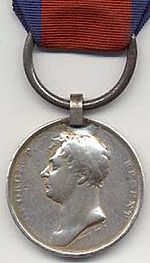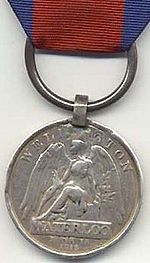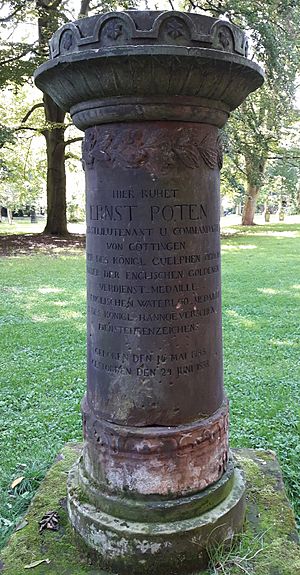Waterloo Medal facts for kids
Quick facts for kids Waterloo Medal |
|
|---|---|
 
Obverse and reverse of the medal.
|
|
| Type | Campaign medal |
| Eligibility | British Army |
| Awarded for | Campaign service |
| Campaign(s) |
|
| Description | Silver disk 35 mm wide |
| Clasps | None |
| Statistics | |
| Established | 10 April 1816 |
| Ribbon: crimson with dark blue edges | |

The Waterloo Medal is a special award given to soldiers. It was for every officer, non-commissioned officer (like sergeants), and soldier in the British Army. This included members of the King's German Legion, a group of German soldiers fighting with the British.
This medal was given to those who fought in one or more of these important battles:
- Ligny (June 16, 1815)
- Quatre Bras (June 16, 1815)
- Waterloo (June 18, 1815)
Contents
History of the Medal
After the big victory at Waterloo, the House of Commons (a part of the British Parliament) decided to create a medal. This medal would be for everyone who took part in the campaign.
The Duke of Wellington, a famous British general, supported this idea. On June 28, 1815, he wrote a letter. He suggested giving a medal to the non-commissioned officers and soldiers. He believed it would be very good for the army.
On September 17, 1815, the Duke of Wellington wrote again. He recommended that all soldiers should get the same medal. He also suggested it should hang from the same ribbon as the Army Gold Medal.
The medal was given out in 1816 and 1817. Every soldier who was at Ligny, Quatre Bras, or Waterloo received one. Each soldier also got two extra years of service and pay. This counted towards their rank and pension. These soldiers became known as "Waterloo Men." The medal was officially announced on April 23, 1816.
This was the first time the British Government gave a medal to all soldiers in a battle. Other medals, like the Military General Service Medal, were for earlier battles. But they were not given out until much later, in 1848. The Waterloo Medal was also the first campaign medal given to the families of soldiers who died in battle.
At the time, giving out medals like this was not common. Soldiers who received it were very happy. However, some veterans of the Peninsular War felt a bit unfair. They had fought in many battles for years. But they had not received a medal for their service. Meanwhile, new recruits who only fought at Waterloo got this special award.
Still, the medal showed how important the victory at Waterloo was. It also started a new tradition of giving campaign medals to many soldiers.
How Many Medals Were Given?
About 39,000 Waterloo Medals were made. Not all of them were given out. Here is a breakdown of who received them:
- Around 6,000 went to cavalry soldiers (who rode horses).
- About 4,000 went to Foot Guards (special infantry units).
- Roughly 16,000 went to infantry line regiments (regular foot soldiers).
- Around 5,000 went to artillery (soldiers who used cannons).
- About 6,500 went to the King's German Legion.
- With staff, Sappers and Miners, and the Royal Waggon Train, about 38,500 medals were given in total.
What the Medal Looks Like
The medal is made of silver. It is about 37 millimeters (1.46 inches) wide. Thomas Wyon, a skilled engraver, designed the medal. At first, they thought about making them from bronze. But they decided to make them from fine silver instead.
Here is what the medal's design looks like:
- Front (Obverse): It shows a picture of the Prince Regent facing left. Around the edge, it says "GEORGE P. REGENT".
- Back (Reverse): It shows a figure of Victory sitting on a platform. Above her, it says "WELLINGTON". Below, it says "WATERLOO" and the date "JUNE 18 1815". This design was inspired by an old Greek coin from Elis. That coin is now in the British Museum.
- How it hangs: The ribbon goes through a large iron ring on top of the medal. This ring is attached to the medal with a steel clip. Many soldiers later changed this to a fancier silver hanger.
- Ribbon: The ribbon is 37 millimeters (1.46 inches) wide. It is crimson (a deep red) with dark blue edges. Each blue edge is about 7 millimeters (0.28 inches) wide. This is the same "military ribbon" used for the Army Gold Medal. It was also used later for the Military General Service Medal. Soldiers wore the medal itself on their uniform. There was no smaller "ribbon bar" to wear instead.
- Naming: This was the first British medal where the soldier's rank, name, and regiment were carved around the edge. A special machine was used to press the names into the medal's rim. This machine was made by two workers from the Royal Mint. Any Waterloo Medal that is engraved differently has likely been renamed later. Any medal without a name either had the name removed or is a "specimen" (a sample medal).
The design of the Waterloo Medal, including its size, metal, and how names were added, became a model. It set the standard for most British campaign medals that came after it.
Other Waterloo Medals
Seven different countries that fought in the Seventh Coalition also made medals for their soldiers. These medals were for those who took part in the Waterloo campaign:
- This medal for British and King's German Legion troops.
- Brunswick Waterloo Medal
- Hanoverian Waterloo Medal
- Nassau Waterloo Medal
- Netherlands Silver Memorial Cross, 1813–1815 (Zilveren Herdenkingskruis), given in 1865.
- Prussian Campaign Medal, 1813–15 (Kriegsdenkmünze)
- Saxe-Gotha-Altenburg Medal, 1814–15
See also
- St. Helena Medal issued to French veterans

